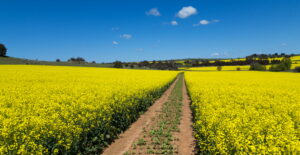The last fortnight has seen a return to the rampant volatility which has been missing from grain markets for much of the last four months. The drivers are well documented, with the weather shifting in the US, along with more geopolitical moves around Russia. Locally, markets are taking some notice, but price movements are far less dramatic.
Chicago Soft Red Wheat Futures (SRW) have had a rather extreme couple of weeks. After bouncing along the bottom of the 18-month range for a couple of months weather issues saw them take off. Normally at this time of year, short covering rallies like the one we saw in June tend to remain in place, as weather issues rarely reverse in time.
What we have seen however is the wetter weather reversing the price trend. Corn crops are benefitting, and wheat is falling by association. Add in the fact that the US winter wheat harvest is well on its way, and prices have eased sharply as growers try to grab some of the better values.
Figure 1 shows SRW gaining over $60/t, and then promptly losing it across the course of three weeks. Moves in the local ASX Wheat futures were far more benign. ASX Wheat has been trading at a premium to SRW due to the expected small crop. Buyers were not, however, at all interested in maintaining that premium while the US price rallied, with the basis becoming negative.
ASX wheat prices have eased a little with the SRW fall, but again, not nearly as much, and as a result basis is back between $25-30.
In canola markets, the lack of reaction to the USDA’ cut in soybean acres has been surprising. Soybean futures jumped higher, but Matif Rapeseed remained steady. As such local canola values have remained in the $640-650/t, and at a $70 discount to Matif.
Normally we would expect the rally in soybeans to support canola, and add in the news regarding dryer weather during crop development in Canada, there could be some upside on the horizon.
What does it mean?
The selling opportunity in SRW swaps is gone for now, but locally prices are still relatively strong. The good news is that we are nearing the halfway point of the US winter wheat harvest, and price pressure from that corner shouldn’t get a lot stronger.
Canola is stuck between weakening demand, and potential issues with supply. The market’s reaction is to tread water and wait for direction.
Have any questions or comments?
Key Points
- US wheat prices have been very volatile in recent weeks, much less so here.
- Canola values have failed to react to rising soybean prices yet.
- There is potential upside for both wheat and canola values.
Click on figure to expand
Click on figure to expand
Data sources: CME, ASX, Mecardo














